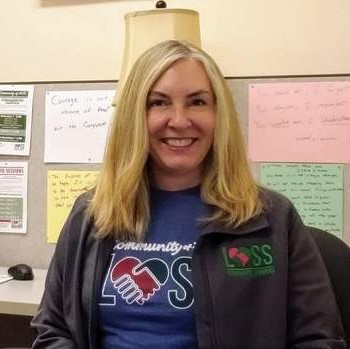Four years ago, Sondra Workman lost a loved one to suicide. As she grieved, she pledged to do something to help others: to learn and share techniques that can help prevent suicides. Cigna, her employer, gave her paid time off work and funding to amplify her efforts through its Community Ambassadors Fellowship program.

Four years ago, Sondra Workman lost a loved one to suicide. As she grieved, she pledged to do something to help others: to learn and share techniques that can help prevent suicides. Cigna, her employer, gave her paid time off work and funding to amplify her efforts through its Community Ambassadors Fellowship program.
 “I started researching how people can make a difference in their communities,” said Workman, a clinical program senior advisor for Evernorth, Cigna’s health services business. “I believe that the stigmas surrounding behavioral health issues kept my loved one from seeking help. By helping people understand risk factors and learn prevention strategies, we can reduce suicides.”
“I started researching how people can make a difference in their communities,” said Workman, a clinical program senior advisor for Evernorth, Cigna’s health services business. “I believe that the stigmas surrounding behavioral health issues kept my loved one from seeking help. By helping people understand risk factors and learn prevention strategies, we can reduce suicides.”
Her research showed that the suicide rate in the United States has increased by 35% during the last 20 years. The American Foundation for Suicide Prevention reports that 45,979 Americans died by suicide in 2020 and an estimated 1.2 million Americans attempted suicide, making it the 12th leading cause of death in the U.S.
Why Men Are at Increased Risk of Suicide
Like Workman’s loved one – who was 21 when he died – men often suffer in silence, and men are three times more likely to die by suicide than women. Among all genders, suicide is the second leading cause of death among people ages 10 to 34.
American cultural norms can discourage men to seek behavioral health care, she said, but we can change that pattern and reduce stigma by talking about behavioral health. Doing so can normalize struggles and reduce stigmas, allowing men to speak without shame about their experiences.
Working to Reduce Suicides, One County at a Time
Workman enrolled in a program offered by the QPR Institute, which taught her about the warning signs of suicide and how to help someone in crisis. She became certified in QPR, which stands for Question, Persuade, and Refer, and began to plan in-person training for speakers for her local support group. Then the pandemic hit – but Workman was able to find a way to make an impact from home.
Her local nonprofit affiliate, Franklin County (Ohio) Local Outreach to Suicide Survivors (LOSS) Community Services, often receives requests for speaking engagements but lacked the capacity to find experts and resources. Utilizing three months of paid leave and funding provided by the Cigna Fellowship, Workman created an online speaker’s bureau that provides a simple way for community organizations and individuals to find the sources and speakers they need. Despite operating virtually, Workman said they were able reach a wide audience. In addition, her work has been featured in local and national media campaigns.
Since beginning her fellowship, Workman has talked with others who have lost loved ones to suicide and helped them tell their stories. “These conversations are just as important as formal training because they help spread the word,” she said – and the speakers bureau amplifies their voices.
How You Can Help Prevent Suicides
Workman’s loved one suffered in silence and didn't tell anyone about how he felt. “He might still be here today if his family had known the risk factors and suicide prevention strategies,” she said.
She shared risk factors and warning signs compiled by the American Foundation for Suicide Prevention and the Centers for Disease Control and Prevention, which can indicate an increased possibility of suicide.
- Risk factors:
- Behavioral health conditions such as depression, anxiety disorders, and substance use problems
- Traumatic brain injury
- Previous suicide attempts
- Childhood abuse, neglect, or trauma
- Stressful life events or prolonged stress
- Barriers to health care
- Stigma associated with behavioral health
- Exposure to another person’s suicide
- Warning signs:
- Talking about self-harm, feeling hopeless, or having no reason to live
- Increased use of alcohol or drugs
- Isolation from friends and family
- Saying “goodbye” to people
- Withdrawing from normally enjoyed activities
- Displaying depression, anxiety, loss of interest, agitation/anger, or relief/sudden improvement in mood
- Fortunately, protective factors can help create supportive environments. They include:
- Coping and problem-solving skills
- Connections to friends, family, and community support
- Supportive relationships with care providers
- Creating a strong sense of self-esteem
- Limited access to firearms, poison, and other lethal method
If you think someone is thinking about suicide, Workman said, be sensitive in your efforts to reach out privately and listen to their story. Avoid minimizing their problems or giving advice, and encourage them to seek help from a professional, such as their doctor or a therapist. Reaching out is important, she said: Even one conversation can save a life.
Working for a Better Tomorrow
Ideally, Workman said, we should consider behavioral health issues in the same way do physical health issues. For example, the pink ribbon is universally recognized as a symbol of breast cancer awareness. “I believe it would benefit everyone to make the green (mental illness) and purple-teal (suicide prevention) ribbons just as visible and compelling,” she said.
“My work at Franklin County LOSS was extremely humbling," she said. "Witnessing the army of individuals who care deeply about suicide prevention was inspirational and moving. Working alongside suicide loss survivors, and having the privilege of editing their stories, had a profound impact on me. Vulnerability is courage, and it’s a powerful teacher of respect and kindness.”
To find similar support groups or initiatives in your own community, look to the American Foundation for Suicide Prevention (AFSP) for local chapters and resources on how to save a life. If you’re dealing with suicidal thoughts or concerned about someone else call the National Suicide Prevention Lifeline at 800-273-8255. Starting July 16, callers can also reach the lifeline by dialing just three digits: 988.

Suicide Awareness and Prevention
Suicide and suicide attempts are devastating acts that can seem to have come from nowhere. Cigna wants everyone affected to know you are never alone.